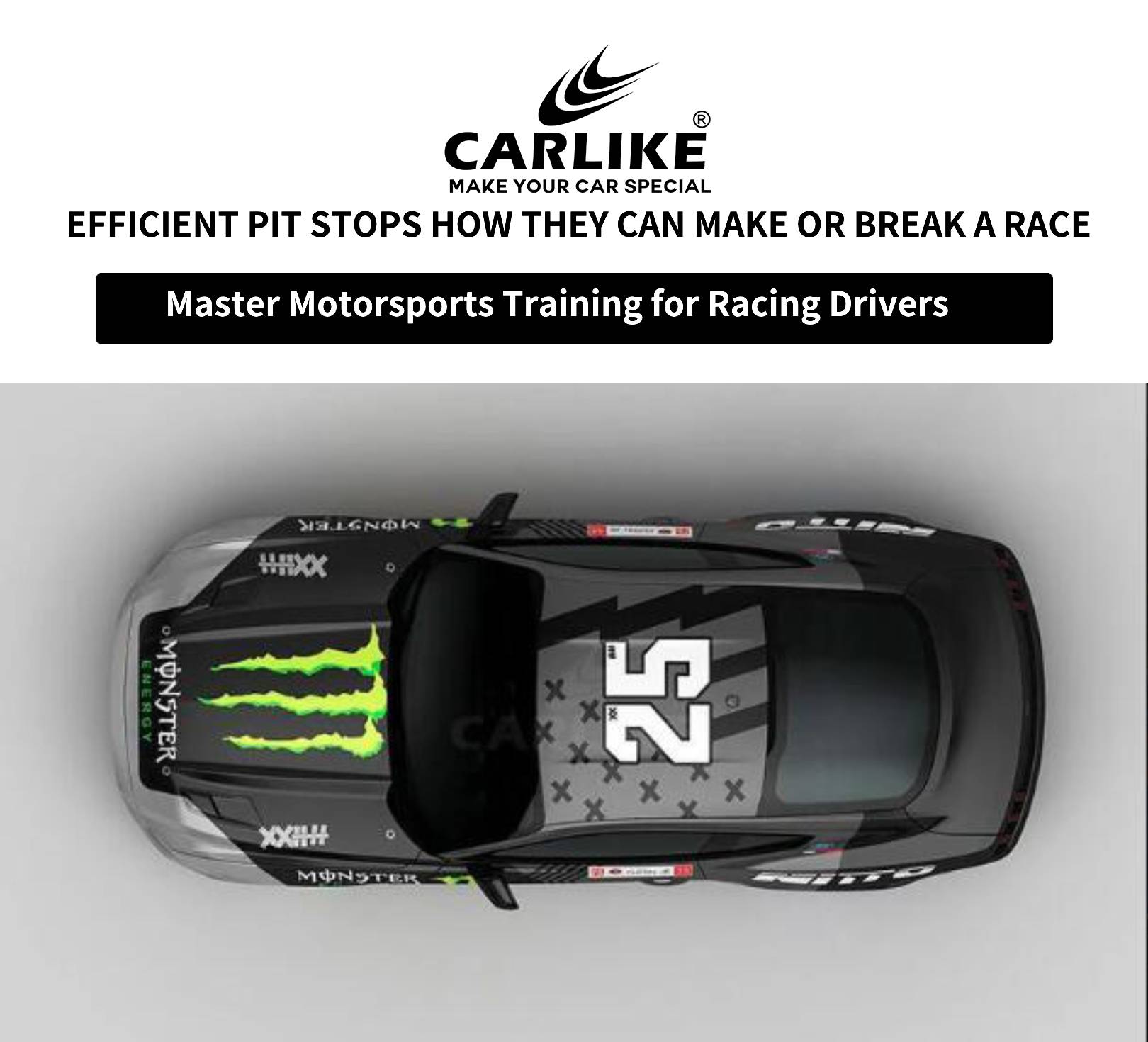CARLIKE-Make Your Car Special.
Professional Customized Race Track Car Sticker
Premium+ Colored Printed Customized Graphics Car Wraps
Epson High-Precision Printing
Inside the World of Professional Motorsports Ⅱ

Powertrain and Engine Dynamics: The Heart of a Race Car
Powertrain
The powertrain of a race car encompasses all the components that generate power and deliver it to the road. This includes the engine, transmission, driveshaft, differentials, and axles. The primary objective of the powertrain in a race car is to maximize power output and efficiently transfer it to the wheels for optimal performance.
1. Engine
- Type: High-performance race cars often use engines specifically designed for racing, such as naturally aspirated V8, V10, or V12 engines, turbocharged or supercharged inline-4 or V6 engines.
- Materials: Lightweight and strong materials like aluminum and carbon fiber are used to reduce weight and increase strength.
- High Rev Limits: Race car engines are designed to operate at high RPMs (revolutions per minute), often exceeding 10,000 RPM, to maximize power output.
2. Transmission
- Type: Sequential manual transmissions are common in race cars, allowing for rapid gear changes with minimal power loss.
- Gear Ratios: Optimized gear ratios ensure that the engine operates within its optimal power band throughout the race.
- Clutch: Multi-plate clutches are used for their ability to handle high torque and provide quick, reliable engagement and disengagement.
3. Differentials:
- Limited-Slip Differential (LSD): This type of differential helps maintain power delivery to the wheels, especially during cornering, by limiting the slip between the left and right wheels.
- Torque Vectoring: Some race cars use advanced torque vectoring systems to distribute power dynamically between the wheels, improving handling and traction.
4. Driveshaft and Axles
- Lightweight and Strong: These components are made from materials like carbon fiber or high-strength steel to withstand the high torque and stresses of racing while minimizing weight.
Engine Dynamics
The dynamics of a race car engine involve the various factors that influence its performance, efficiency, and reliability during high-stress racing conditions.
1. Air Intake and Exhaust Systems
- Forced Induction: Turbochargers or superchargers are often used to increase the amount of air entering the engine, significantly boosting power output.
- High-Flow Exhaust: Race cars use exhaust systems designed to minimize backpressure and enhance the expulsion of exhaust gases, improving engine efficiency and performance.
2. Fuel Injection and Management
- Precision Fuel Injection: Advanced fuel injection systems ensure the precise delivery of fuel to the engine, optimizing the air-fuel mixture for maximum power and efficiency.
- Engine Control Unit (ECU): Modern race cars are equipped with sophisticated ECUs that monitor and adjust engine parameters in real-time to optimize performance.
3. Cooling Systems
- High-Efficiency Radiators: Essential for maintaining optimal engine temperatures during intense racing conditions.
- Oil Coolers: Help manage the temperature of the engine oil, ensuring consistent lubrication and preventing overheating.
4. Ignition System
- High-Performance Spark Plugs and Coils: Ensure reliable ignition of the air-fuel mixture, crucial for consistent power delivery.
- Advanced Timing: Precise control of ignition timing helps maximize power output and efficiency.
5. Lubrication System
- Dry Sump Oil System: Common in race cars, this system helps ensure consistent oil pressure and lubrication during high-speed cornering and acceleration.
In summary, the powertrain and engine dynamics of a race car are meticulously engineered to achieve the highest levels of performance, efficiency, and reliability. Every component is optimized to handle the extreme conditions of racing, providing drivers with the power and control needed to compete at the highest levels.
Suspension and Handling: Balancing Speed with Control
Suspension System
The suspension system in a race car is critical for maintaining maximum tire contact with the road surface, which directly influences grip, handling, and overall performance. Key components and aspects include:
Spring and Damper (Shock Absorber) Setup
- Springs: Support the weight of the car and absorb energy from bumps. They can be coil springs, leaf springs, or torsion bars.
- Dampers: Control the rate of suspension movement. High-quality adjustable dampers allow fine-tuning of compression and rebound rates to suit different tracks and conditions.
Anti-Roll Bars (Sway Bars) :
These bars connect the left and right wheels to reduce body roll during cornering. Adjustable anti-roll bars help in tuning the balance between understeer and oversteer.
- Control Arms: These are the linkages that connect the wheels to the chassis. They allow for precise control of wheel alignment and suspension geometry, critical for maintaining optimal tire contact.
Bushings and Bearings: These components reduce friction and allow smooth movement of suspension parts. High-performance bushings and bearings are often used to enhance responsiveness and durability.
Handling Characteristics
Handling refers to how a race car responds to driver inputs, particularly in terms of steering, cornering, and overall stability. Key factors influencing handling include:
Weight Distribution: Proper weight distribution (front-to-rear and side-to-side) is crucial. Race cars often use ballast to achieve an optimal balance, ensuring stability and predictable handling.
Center of Gravity: Lowering the center of gravity reduces body roll and improves cornering ability. Race cars are designed to have a low center of gravity to enhance stability.
Aerodynamics: Aerodynamic elements such as spoilers, splitters, and diffusers create downforce, increasing grip and stability at high speeds. Effective aerodynamics allow for better cornering and reduced drag.
Tire Choice and Management: Tires are the only contact points between the car and the track. Selecting the right tire compound for specific track conditions and managing tire wear are crucial for maintaining grip and performance.
Steering System: Precision steering systems with quick response times allow drivers to make accurate inputs and maintain control. Adjustable steering racks and power steering systems can be fine-tuned for different driving styles and track layouts.
Fine-Tuning for Performance
Race cars require meticulous setup and adjustments to optimize handling for different tracks and conditions. Common adjustments include:
Camber, Caster, and Toe :
- Camber: The tilt of the wheels relative to the vertical axis. Negative camber can improve cornering grip.
- Caster: The tilt of the steering axis. Positive caster enhances straight-line stability and cornering performance.
- Toe: The angle of the wheels relative to the car’s centerline. Toe-in or toe-out adjustments affect stability and turn-in response.
Ride Height and Corner Weighting: Adjusting ride height affects the car’s center of gravity and aerodynamics. Corner weighting ensures that each wheel carries the optimal load for balanced handling.
Damping Settings: Fine-tuning damper settings (compression and rebound rates) allows the suspension to absorb bumps and maintain tire contact without excessive body movement.
By carefully managing these aspects, race teams can maximize the performance of their cars, giving drivers the best possible handling and stability on the track.




